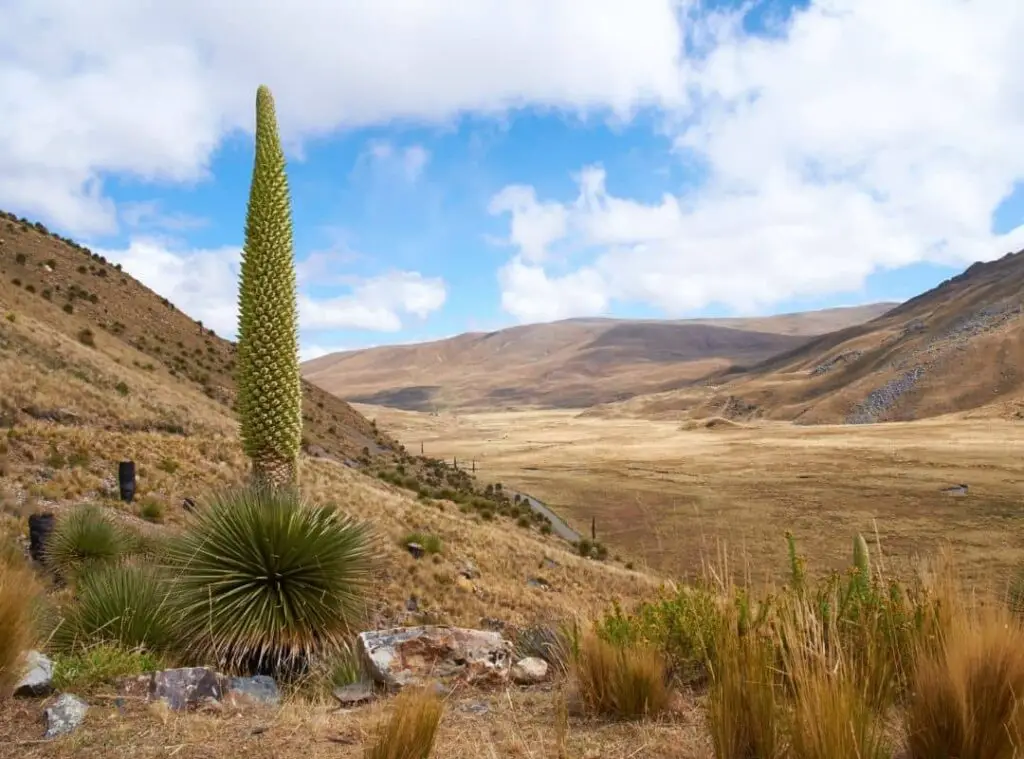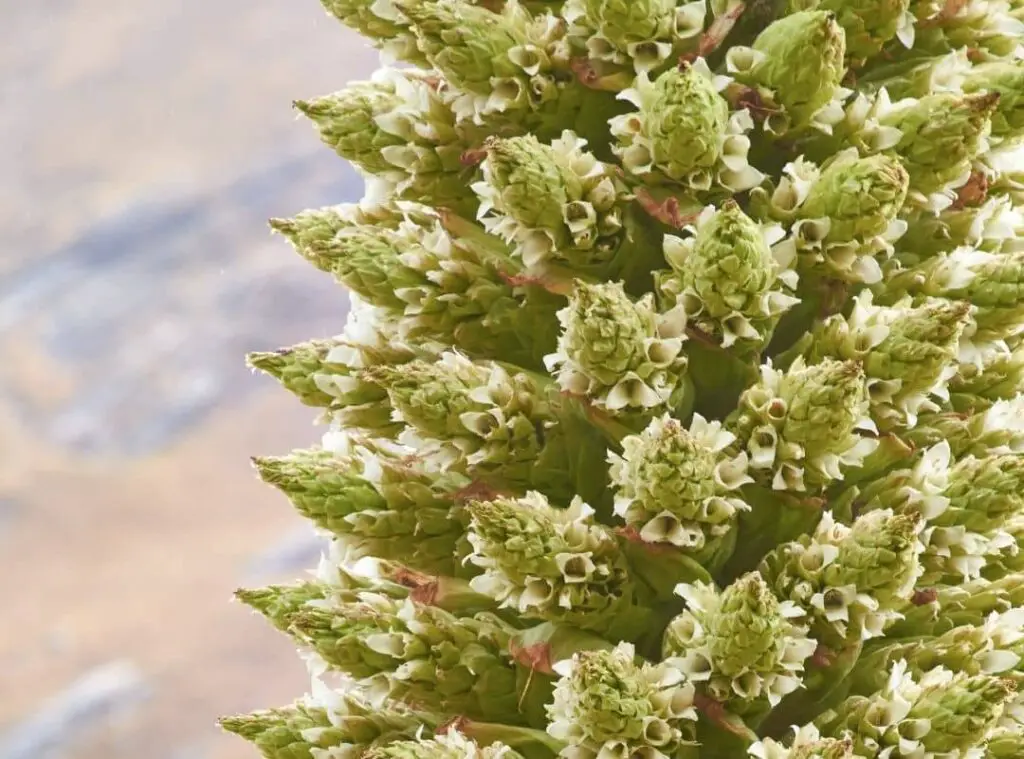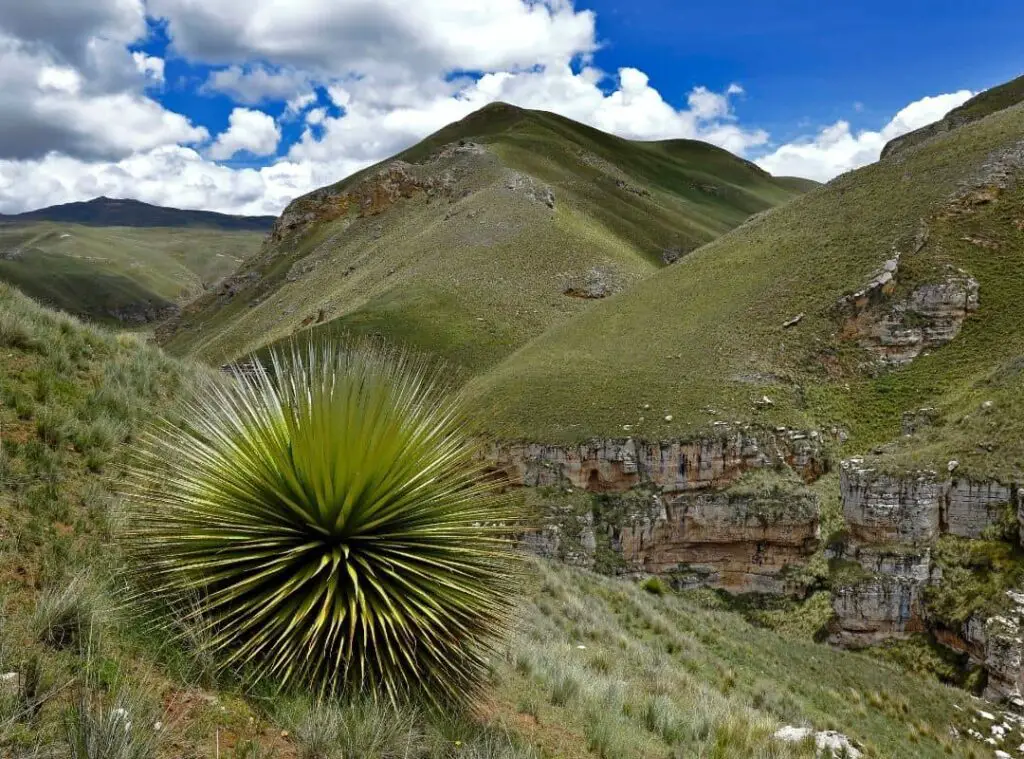Puya raimondii are native plants to Peru and Bolivia and they are one of the most beautiful sets of plants which you may come across in the entire plant’s world.
Puya raimondii is in fact the largest of all bromeliads which could grow up to about 12 – 15 meters. In fact, their flower spikes themselves would be about 9-10 meters.
These are known as the queen of the Andes Titica, and their life span is very long as 100 years. Puya raimondii belong to the bromeliads genus and they consist of about 23 species which are native to South America and to Southern central America.
You could find them growing in the Andes in those areas. Puya raimondii are rosette forming plants which usually form slightly fleshy leaves which you could spot in green to gray colors.
So, if you wish to find out more on these amazing plants, keep reading this article as we will be covering their growing requirements and on the care tips as well.

How do I identify puya raimondii?
They have sharp leaves which have hook-like spines at the tip and along the edges, and may be as much as 3 metres in length; they are arranged in a rosette, very rigid, and possess considerable mechanical strength.
The leaves are slightly fleshy and they may tend to take a green or a gray color. Moreover, they comprise densely made hairs as well.
Size of the plant
Puya raimondii would reach a height of 12 meters.
Growth rate
This plant is a slow growing plant. They grows approximately 1 cm a month, and at age 28 years might reach the size of about 3.36 m.
One look care guide
| Botanical Name | Puya raimondii |
| Common Name | Queen of the Andes |
| Plant Type | Succulent |
| Mature Size | 12 -15 meters ( ~ 30 feet) |
| Sun Exposure | Full sunlight to Partial shade |
| Soil Type | Well-draining |
| Soil pH | neutral or slightly acidic |
| Bloom Time | May and June |
| Flower Color | White |
| Hardiness Zones | USDA hardiness zones 9b-10. |
| Native Area | Peru and Bolivia |
| Toxicity | No record |
| Average price for seed | USD 6 (for ~ 5 seed) |

How do you take care of puya raimondii?
Light Requirement
They would grow in bright sunlight. However, they do not prefer to be exposed to direct sunlight though.
If you grow them as houseplants and if you think they are lacking adequate sunlight, you could grow them closer to grow lights such as fluorescent or LED bulbs.
However, when you keep them ensure that you keep them at a distance of 4 inches from the plants.
Temperature and humidity
Puya raimondii usually grow in high altitudes where there will be colder temperature levels. In fact, they can grow in colder temperatures such as in -20 degrees Celsius to 8-24 degrees Celsius.
Is it cold hardy?
Puya raimondii are cold hardy up to – 6 degrees Celsius. 9 20 degrees Fahrenheit)
USDA Hardiness Zone
Puya raimondii prefer to grow in USDA hardiness zones 9b-10.

Watering Requirement
It is important that you water the Puya raimondii properly as that will have a greater impact on the plants well being and on the vigorous growth.
In fact, Puya raimondii will thrive well with once-a-week watering or once every couple of weeks watering during summer.
It is important that you water them well so that it will avoid wilting of the plants particularly if you are growing them in extreme heat conditions.
If in case, you grow them in heated weather conditions and fail to water them properly it will result in burns of the plants.
Flowers
Puyas take decades to produce flowers. The floral axis or inflorescence (the complete flower head of a plant including stems, stalks, bracts, and flowers) is 4-8 m long.
They produce beautiful white color flowers and the flowering begins in early May and June, continuing into July; by October it has reached its full length, but flowering continues to mid-December.
The seeds are dispersed the following July. It has been estimated that a plant can produce some 12 million seeds they are small and winged, easily transported by the wind
Puya raimondii are monophoric plants.

Soil Requirement Type / ph.
Puya raimondii will perform well in a well-draining soil mix. Ideally a cactus soil mix or a succulent soil mix would perfectly fit in for these.
It is important that they have a well-draining soil mix since it will not retain any additional moisture in the potting medium. Ideally a sandy soil mix which has pumice perlite or gravel would be ideal to use to grow the Puya raimondii.
In terms of the right pH of the soil mix, they would perform well in neutral or slightly acidic soil mixes.
If you experience constant rainfalls, you could be tactful in making a 1m X 1m hole and fill it with some substrate mentioned above. It will ensure that there is no rotting taking place.
Pot size Potting and Repotting
When it comes to selecting the right pot to grow them, ensure that they have sufficient draining holes for the excess water to move through.
Furthermore, when it comes to repotting you could do it only if it is required. Furthermore, select a slightly larger pot when repotting them so that they have adequate space to grow the roots.
Where to Plant
If you are wondering where to plant your Puya raimondii plants, you need to select a soil mix which has less nutrients and which has a fast draining as well.
Hence as aforesaid, you may go ahead with a readily available cactus soil mix or with a readily available succulent soil mix.
In addition to that wherever you plant them, ensure that the plants get adequate sunlight levels.

Fertilizer and time of year
You may consider feeding the Puya raimondii plants from spring to fall. You may go ahead with a liquid fertilizer to feed them.
Further when adding fertilizers ensure that you are adhering to the labelled instructions so that the growth of the plants would be benefitted from that.
Ensure that you do not overfeed them since it could lead to feed burns in the plants and chances are that it may even cause the plants to die.
Toxicity
No any record about their toxicity
How to propagate puya raimondii
Puya raimondii only propagated through seeds. If you wish to go ahead with the seed’s methods, you could simply sow the seeds in seedling trays which you have filled with substrate.
Ideally the substrate should consist of perlite in equal parts. Place two seeds maximum in one alveolus. Next, cover them with thin layers of substrate and water them lightly.
After that you could place it outdoors where they can get partial shade. Ensure that the soil is moist and damp and soggy. It would take about 10 days’ time for the germination to take place.
Puya raimondii plant benefits
- Puya raimondii are useful as ornamental plants.
- Use as animal fodder: animals at pasture graze on the inflorescences,
- Extract medicine to treat respiratory-tract diseases (in folk medicine).
- The dried flower stems are used to make furniture, for paving and flooring, etc.,
- Dried leaves are used to fence off home-steads, gardens, and animal compounds.
- Also used for religious or magical purposes, and the ash is used to masticate coca.
Conclusion
Puya raimondii is the largest member of the family Bromeliaceae. Due to its huge size every one can not grow this succulent in their garden.
Since it grows up to 30 feet in height, It needs a lot of space. Puyas have stiff leaves and sharp spines and it makes them a bit more difficult to manage.
However Puya raimondii is a valuable gem for rare and unique succulent collectors.
Read Next : Kalanchoe Rosei Variegated | Simple But Elegant Succulent |
